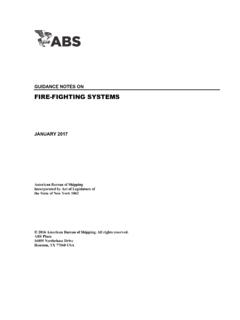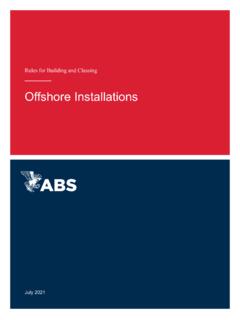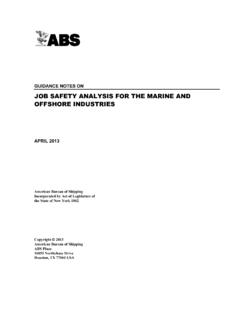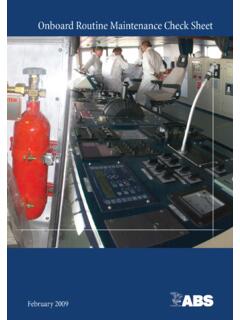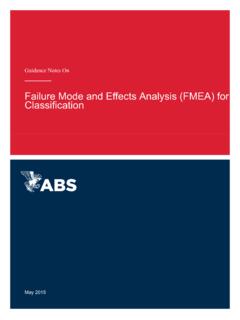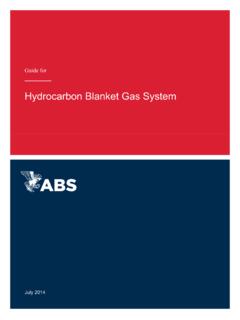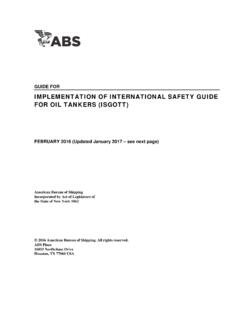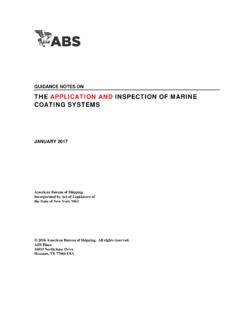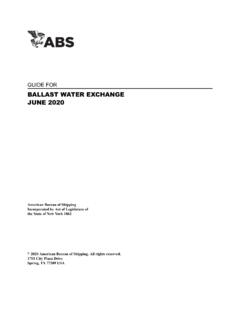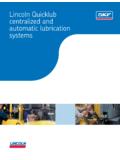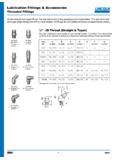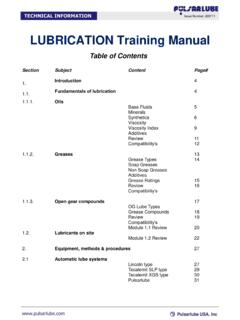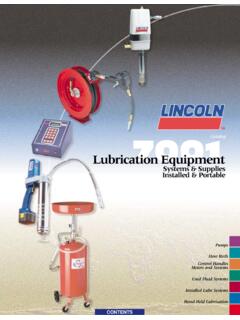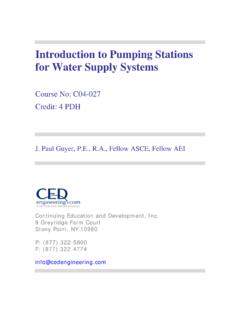Transcription of Air Lubrication Technology - ABS
1 1 | AIR Lubrication Technology Air Lubrication Technology April 1, 2019 2 | AIR Lubrication Technology AIR Lubrication Technology OVERVIEW In 2018, the International Maritime Organization released an initial strategy on the reduction of greenhouse gas emissions from ships with a clear framework to reduce ship emissions. In an effort to lower carbon emissions and to comply with increasing Energy Efficiency Design Index (EEDI) Phase III levels, various energy saving technologies, such as air Lubrication , have been developed to meet the industry need. Air Lubrication systems are recognized by IMO as a Category B-1 Innovative Energy Efficiency Technology as described in This document provides an introduction to air Lubrication Technology for shipbuilders, shipowners, and other interested parties by presenting a summary of reported full-scale sea trials and current developments.
2 Figure 1: IMO 815 Annex Schematic illustration of an air Lubrication system BACKGROUND One of the earlier applications using air bubbles on vessels was the Prairie/Masker Air system developed by the National Defense Research Committee in US Navy Laboratories since post World War II (Domenico, 1982). The Masker system emitted air bubbles under the hull, concealing engine room noise. The Prairie system emitted bubbles around the propeller. Both systems were envisioned to silence the ship acoustically, thus making less detectable by sonar. Scientists and scholars later became interested in air Lubrication Technology for its potential to reduce drag resistance on the hull.
3 In ship resistance, the three main components are frictional resistance, form resistance and wave resistance. For higher speed displacement vessels, the frictional resistance is approximately 40%, but for low speed displacement vessels, the frictional resistance is the dominant contributor and can reach 85% of the total resistance. For low-speed vessels, a reduction on the frictional resistance would result in an even higher reduction in fuel 3 | AIR Lubrication Technology consumption in addition to what is achieved by the traditional optimization of the ship s hull form, addressing the form resistance and wave resistance components.
4 Skin frictional resistance depends on the wetted surface area of a ship. Air Lubrication Technology can reduce this frictional drag for vessels, especially since this Technology does not introduce major changes in hull form and the air injection rate can be adjusted. Without major changes in hull form or change in operational speed, the form and wave resistance are mostly fixed and only frictional drag is reduced. Air Lubrication is achieved by pumping air beneath the hull, reducing the area of hull in direct contact with the liquid flow, or in the case of discrete bubbles, by modification of momentum transport and average density in the boundary layer.
5 There are three major categories of air Lubrication Technology being studied now: Bubble Drag Reduction (BDR), Air Layer Drag Reduction (ALDR), and Partial Cavity Drag Reduction (PCDR). Bubble Drag Reduction (BDR) The more efficient Bubble Drag Reduction uses very small or even micro-sized bubbles. The size of the these bubbles is generally less than mm. However, micro-bubbles can be difficult to produce on a full-scale ship, and are less effective at low speeds due to buoyancy. As bubbles grow in size they can no longer maintain their spherical shape, making them prone to deform in turbulent flows.
6 There is currently no well-established theory on the mechanisms of skin friction reduction by bubbles. One mechanism which appears to be agreed on by researchers is that the addition of bubbles to a liquid effectively reduces the liquid density, hence the Reynolds stress, resulting in a skin friction reduction. Other two possible mechanisms are: The turbulence suppression effect, wherein the bubbles suppress the turbulence in the boundary layer which reduces skin friction Bubbles decrease the effective viscosity of the flow due to the increase of the void fraction Early pioneers experimenting with bubble drag reduction were McCormick and Bhattacharyya (1973) and Madavan et al.
7 (1985). The experiment by McCormick and Bhattacharyya measured the drag force of a fully submerged body layered with hydrogen bubbles created by electrolysis. As the test body was towed at a constant speed, the skin friction reduction increased to 80% with the presence of micro-bubbles. Madavan et al. used the boundary layer of the test section of a wall tunnel with air injection from a porous plate. The national Dutch research project Project Energy-saving air- Lubrication Ships (PELS) was formed in 1999 to study the three air Lubrication techniques, air bubble, air layer and air cavity.
8 PELS studied numerical analysis of these techniques verified with model testing results. The results showed 3-10% average net energy saving in calm water. Two follow up projects (PELS 2 and EU-SMOOTH) were formed to further investigate the effects of air cavity and air bubble/air layer Technology , respectively. Both projects focused on inland and coastal ships and conducted full-scale demonstrator tests. 4 | AIR Lubrication Technology Mitsubishi Air Lubrication (MALS) Mitsubishi Air Lubrication system (MALS) was one of the first commercial air Lubrication systems developed in the marine industry by the Japanese Shipbuilder Mitsubishi Heavy Industries (MHI), based on research developed since the 1980s in Japan.
9 The MALS is a patented air Lubrication system using the BDR method. MHI developed their own turbo blowers specifically used for the MALS, named Mitsubishi Turbo-blower for air Lubrication . R&D Engineering - Winged Air Induction Pipe system (WAIP) Winged Air Induction Pipe (WAIP) comprises a series of small air chambers fitted with a foil for ultra-fine micro-bubble generation and was developed in Japan by Yoshiaki Takahashi and Professor Yuichi Murai. The research was conducted by scholars in Japanese universities beginning in 1998. The WAIP system has been the subject of various tests and is marketed via R&D Engineering Inc.
10 Samsung Heavy Industries SAVER system (SAVER Air) Samsung Heavy Industries (SHI) developed an air Lubrication system , referred as the SAVER system . The SAVER system uses a series of air dispensers installed on the bottom of the ship to spray air bubbles that form an air carpet at the bottom of the ship to reduce frictional drag resistance. Silverstream system Its origins lie in the DK Group, which applied large air cavities to reduce frictional drag. The company evolved into Silverstream Technologies in 2014 to further the commercialization of its patented air Lubrication Technology using smaller air chambers.
